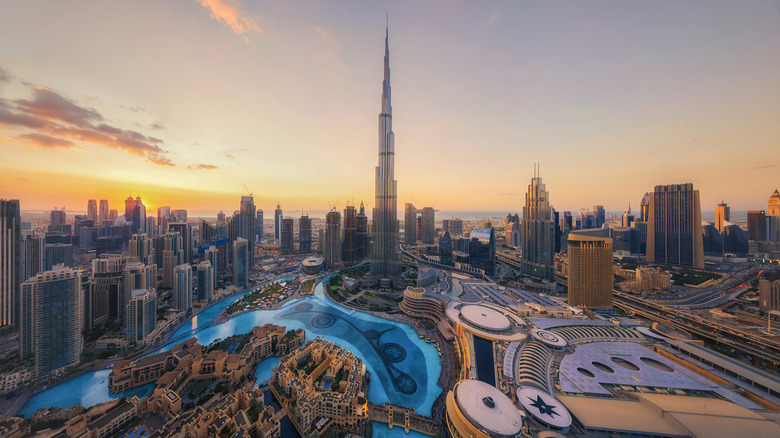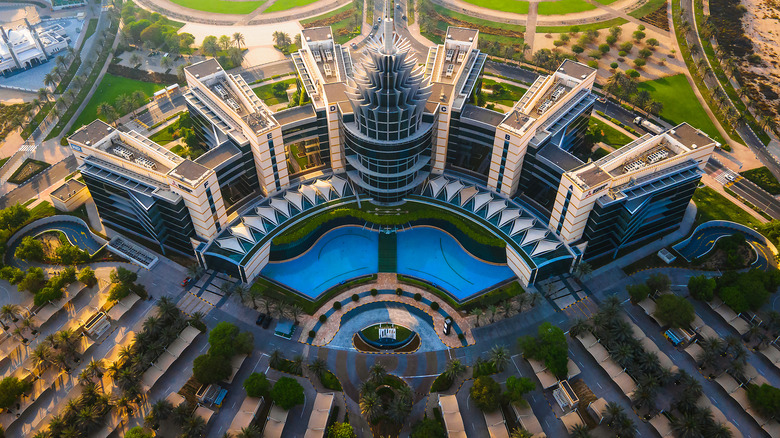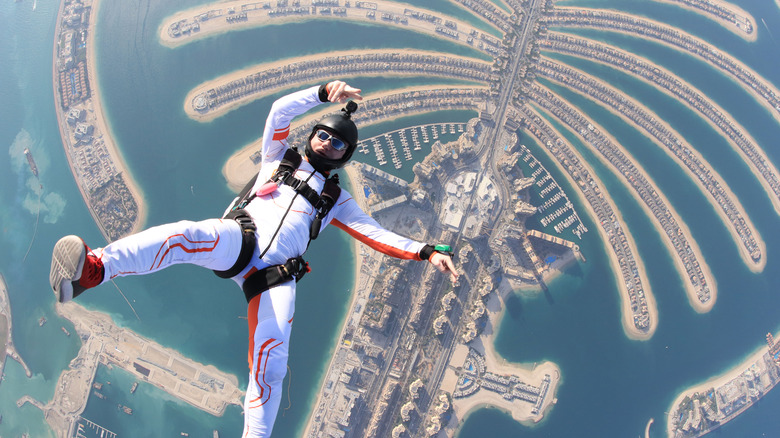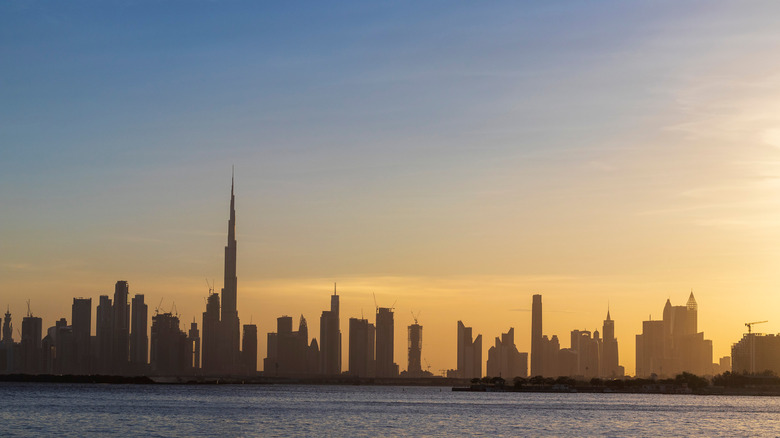How Dubai Is Using Drones To Make It Rain
Yes, folks, Dubai is "making it rain." But shockingly enough for the United Arab Emirates' wealthiest, oil-flush desert city, we don't mean it'll be raining money. We mean the sky-fallen water stuff.
Dubai, having started as a fishing and date-farming village along the Persian Gulf coast by at least 2,500 BCE, has undergone one of the most radical transformations of any human dwelling in history, in an absurdly short amount of time. During the 19th and early 20th centuries, Dubai became something of an economic hub and hotspot for immigrants, as Visit Dubai recollects, but it wasn't until 1966 when its transformation really took off. Why? Oil. Prime Minister Sheikh Rashid bin Saeed Al Maktoum went all out, to say the least, sparing no expense and leveraging any and all technological resources to convert Dubai into what is now — a diverse, global city of 3.4 million, 20th most expensive city in the world to reside, and destination for almost 15 million travelers a year, as of 2016 (per Whereig).
The catch, though? Dubai is in a desert: straight-up cripplingly hot and arid, with full-on desert dunes flowing in the horizon on one side, and the Persian Gulf on the other. And in the middle: a jarring vision of excessive capitalist opulence, with skyscrapers like the current tallest building in the world, the Burj Khalifa, indoor ski resorts, theme and water parks, multi-thousand-dollar-a-night hotels, and futuristic architecture and gardenscapes. And now? Dubai has moved from terraforming to controlling the weather itself.
Part city, part extreme, vulnerable terraforming experiment
Dubai is no stranger to doing its best to technologize the desert and literally reshape the earth (and in the process compose plenty of aerial-friendly shots to allure tourists and investors). The Burj Khalifa, at 828 meters tall (~2700 feet, or over half a mile), is a clever piece of engineering built on 194 concrete shafts driven 50 meters into the sand and held in place by mere friction, as Discovery Australia reports on YouTube. Palm Jumeirah, Dubai's artificial island suburb shaped like a palm tree, was built by dredging up and contouring 120 cubic meters of sand from the ocean floor, enough to circle Earth three times, as Travel Zoo explains.
But there are limits to human terraforming efforts. At one extreme, it would take "several thousand years" from today to terraform the planet Venus — our cousin planet one nearer to the sun — as the educational channel Kurzgesagt explains on YouTube. We're assuming that humanity develops requisite mining, engineering, and spacefaring technology, of course.
Until then, we've got Earth. And Dubai, a metropolitan artifice built in opposition to Earth's nature, is completely vulnerable to not only to its environment, but its own enormous resource demands: energy, manpower, food, and more. Sandstorms rage at speeds of 62 mph. Climate change is deepening both the region's heat and energy demands in turn, particularly for Dubai's perfectly temperature-controlled interiors. And water, despite all of Dubai's open-air swimming pools, is scarce.
Zapping clouds with drones to create rainfall
In June 2021 Portland, Oregon broke 116 degrees Fahrenheit, while Lyton, British Columbia topped out at 122 degrees Fahrenheit, per Interesting Engineering. Both are hotter than the Sahara Desert, which hovers around 114 degrees Fahrenheit. Dubai, roundabout the same latitude as the Sahara (25.28 degrees), is used to this kind of weather, but it's even stressing the limits of a desert-embedded city and its inhabitants.
At present, the UAE has invested $15 million in its "quest to ensure water security," as CBS News puts it. One such venture, out of nine candidates, comes from the University of Reading. Their solution, as All That's Interesting explains, uses drones to "zap" existing clouds with electricity. Charged water molecules zip around the cloud and collide with other molecules, and others, and so on. Eventually, the molecules form droplets. And when droplets get too heavy? Umbrella time.
This is how Dubai recently made it rain, as CBS News reported, using footage of a legitimate desert downpour from the UAE's official weather-based Instagram account. In a region that typically gets no more than 4 inches of rain per year, such efforts can help combat drought in the short-term, yes, and provide some kind of workaround for a much more deep-seated problem of climate change and energy consumption. University of Reading's Robert Van de Noort stated that no matter the size of his university's role, success will ultimately come through partnerships with multiple organizations.
"Rain Enhancement Science" has its detractors and dangers
Of course, such "rain enhancement science" has its detractors, limitations, and dangers. It also has obviously knowable, but not particularly predictable, effects on Earth's ultra-complex network of air and water currents. Besides which, as Van de Noort said to CBS News, "Of course, our ability to manipulate weather is puny compared to the forces of nature."
There are more extreme measures of rain-making on the way, too, which come with their own sets of problems. "Cloud-seeding," for instance, involves triggering the very creation of clouds through the use of "salt crystals coated in titanium dioxide nanoparticles," as Wired explains. How? Just aerosol spray it in the sky like hair spray. In response, the World Health Organization (WHO) has spoken up about the possible carcinogenic problem of people, you know, inhaling titanium. Also speaking of cloud-seeding, Paul Connolly, a researcher at the University of Manchester said, "The problem with the atmosphere is that you can never do a controlled experiment. You can never say what would have happened — in all certainty — if you didn't seed an area." And then, there's the problem of cloud-seeding experiments producing uncontrollable flooding, and their clouds blocking flights.
Also on the docket? In a move seemingly pulled from Frank Herbert's "Dune," the UAE has also considered building an artificial mountain to aid in the creation of clouds, per Engadget. Eventually, the vision goes, the entire region could be lush and verdant.



